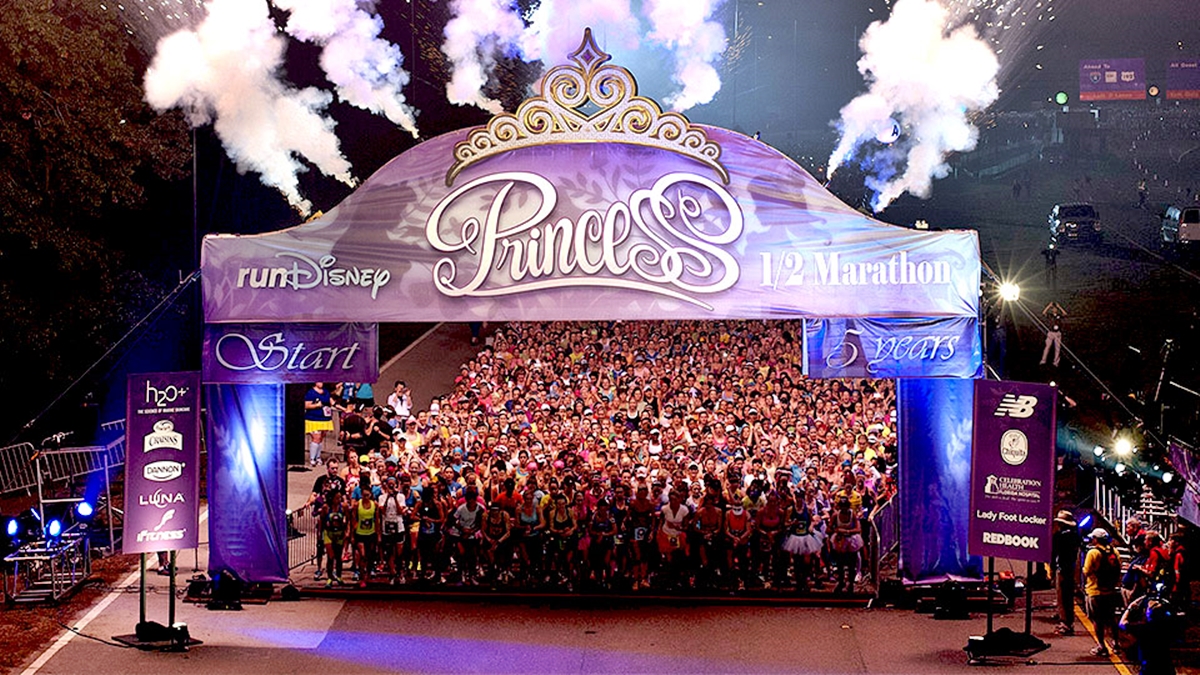Home>Misc>Featured>How To Train For Half Marathon In 3 Months


Featured
How To Train For Half Marathon In 3 Months
Modified: January 22, 2024
Achieve your half marathon goals with our featured training plan, designed to get you ready in just 3 months.
Introduction
Training for a half marathon is no small feat. It requires dedication, perseverance, and a well-structured plan to ensure you are physically and mentally prepared for race day. Whether you’re a seasoned runner looking to push your limits or a novice seeking a new challenge, this comprehensive guide will help you train for a half marathon in just three months.
Running a half marathon is a significant accomplishment that showcases your endurance, strength, and determination. The 13.1-mile race distance is an attractive option for many, as it provides a challenging yet attainable goal. However, it’s important to approach your training with a realistic mindset, allowing yourself enough time to build up your fitness and mileage gradually.
In this article, we will cover various aspects of half marathon training, including setting goals, creating a training schedule, building endurance, incorporating speed work and hill training, cross-training, maintaining a healthy diet, staying hydrated, listening to your body, avoiding overtraining, rest and recovery, mental preparation, race day strategies, and celebrating your achievement. By following these guidelines, you’ll be well-prepared to conquer the half marathon distance.
It’s important to note that the information provided is not a one-size-fits-all approach. Each individual is unique, with different fitness levels, previous running experience, and personal goals. It’s crucial to tailor your training plan to suit your specific needs and consult with a healthcare professional if you have any underlying medical conditions or concerns.
So, if you’re ready to embark on this exciting journey and challenge yourself physically and mentally, let’s dive into the world of half marathon training and prepare ourselves for an unforgettable race day experience.
Setting Your Goal
Before embarking on your half marathon training journey, it’s essential to set a clear and achievable goal. Having a goal in mind will provide you with focus, motivation, and a sense of purpose throughout your training. Here are some key considerations when setting your goal:
- Choose a Specific Distance and Race: Determine if you want to participate in a specific half marathon race or if you prefer to complete the distance on your own. Research different race options in your area or consider virtual races that allow you to participate from any location.
- Consider Your Current Fitness Level: Assess your current fitness level honestly. If you’re a beginner or haven’t been running regularly, it may be more realistic to aim for finishing the race comfortably rather than setting a specific time goal.
- Set a Time Goal (if applicable): If you’re an experienced runner looking to challenge yourself, setting a time goal can be a great way to track your progress and work towards improving your personal record. Analyze your previous race times or set a realistic target based on your current fitness level.
- Take into Account Your Lifestyle: Consider your other commitments and responsibilities, such as work, family, and social activities. Setting a goal that aligns with your lifestyle will make it easier to integrate your training into your daily routine.
- Be Realistic: While it’s important to set ambitious goals, it’s equally crucial to be realistic. Setting a goal that is too aggressive or beyond your capabilities can lead to disappointment or injury. Find the right balance between challenging yourself and staying within your limits.
Once you have defined your goal, write it down and keep it somewhere visible. This will serve as a constant reminder of what you’re working towards and help you stay focused and motivated throughout your training journey.
Remember, your goal can always evolve as you progress through your training. You may find that you surpass your initial expectations or adjust your goal to better suit your current circumstances. Stay adaptable and open to changes as you continue your half marathon training.
Creating a Training Schedule
A well-structured training schedule is crucial for effectively preparing your body for the demands of a half marathon. It helps ensure that you gradually build up your mileage, incorporate rest days, and allow for proper recovery. Here are some steps to help you create a training schedule tailored to your needs:
- Assess Your Current Fitness Level: Before creating your training schedule, evaluate your current running fitness. Consider factors such as your average weekly mileage, longest run distance, and the number of runs per week. This assessment will help you determine an appropriate starting point.
- Determine Your Available Time: Consider your weekly commitments and available time for training. Look for windows where you can fit in your runs consistently.
- Choose the Duration of Your Training: Since you have a three-month timeline, divide it into phases: base-building, building endurance, and tapering. Allocate time for each phase, ensuring that you have adequate weeks to progress safely and allow for recovery.
- Distribute Weekly Mileage: Aim for an increase in weekly mileage of no more than 10% per week. Gradually increase your mileage over the duration of your training, allowing your body to adapt and minimize the risk of injury.
- Incorporate Rest Days: Rest days are just as important as running days. Schedule at least one or two rest days per week to give your body time to recover and rebuild.
- Include Different Types of Runs: Vary your training runs to include long runs, speed work, tempo runs, and easy recovery runs. This variety helps improve different aspects of your running performance and prevents monotony.
- Consider Cross-Training: Cross-training activities such as cycling, swimming, or strength training can complement your running routine by strengthening other muscle groups and reducing the risk of overuse injuries. Allocate specific days for cross-training in your schedule.
- Make It Flexible: Life happens, and some days you may need to adjust your training schedule. Allow flexibility within your plan to accommodate unexpected events or changes in your routine.
- Track Your Progress: Keep a training log to track your runs, mileage, and any notes regarding performance or how you feel during each run. This will help you analyze your progress, identify patterns, and make adjustments as necessary.
Remember, everyone’s training schedule will be different based on their individual circumstances and goals. Listen to your body and make necessary adjustments if you experience pain or excessive fatigue. It’s better to take a step back and prioritize your long-term health and well-being.
Creating a training schedule not only provides structure to your training but also helps you stay motivated and accountable. Having a plan in place will make it easier to follow through, even on days when your motivation is lacking.
Establishing a Base Mileage
Before diving into intense training, it’s important to establish a solid base mileage. Building a strong foundation of running endurance will provide a platform for your half marathon training and help prevent injuries. Here are some tips on how to establish a base mileage:
- Assess Your Current Fitness Level: Evaluate your running fitness level to determine a starting point for your base mileage. Consider factors such as your average weekly mileage, the number of runs per week, and the longest distance you can comfortably run.
- Gradual Increase: Begin with a conservative mileage that allows you to comfortably complete your runs. Increase your weekly mileage by no more than 10% per week to avoid overuse injuries and excessive fatigue.
- Prioritize Consistency: Consistency is key when establishing a base mileage. Aim to run 3-4 times per week, with at least one rest day between each run. Prioritize regular running to build endurance gradually over time.
- Long Runs: Include a weekly long run in your training schedule to build endurance. Start with a distance that is challenging but manageable, gradually increasing the distance each week.
- Ease into Speed Work: While establishing a base mileage, focus on building your endurance rather than speed. Save speed work (such as intervals or tempo runs) for later in your training plan.
- Listen to Your Body: Pay attention to any signs of excessive fatigue, pain, or discomfort. It’s important to give your body time to adapt and recover. If necessary, dial back your mileage or take additional rest days.
- Mix Terrain: Incorporate a variety of terrains into your running routes, including flat surfaces, hills, trails, and tracks. This variation will engage different muscle groups and provide a more well-rounded running experience.
- Monitor Progress: Keep a training log to track your mileage, running times, and how you feel after each run. This will help you track your progress and identify any patterns or areas that may need adjustment.
- Take Rest Days Seriously: Rest days are just as important as running days. They allow your body to recover and adapt to the demands of running. Use rest days to recharge, focus on stretching or cross-training, and help prevent burnout.
Establishing a base mileage sets the foundation for the more intense training to come. By gradually building your endurance, you’ll be better prepared for the volume and intensity of the half marathon training plan. Remember, patience is key during this phase. Allow your body time to adapt, and be consistent with your training to set yourself up for success.
Building Endurance
Building endurance is a critical component of half marathon training. It allows you to run longer distances with more ease and helps you maintain a steady pace throughout the race. Here are some strategies to help you improve your endurance:
- Gradual Increase in Mileage: Increase your weekly mileage gradually over time. Aim to add 1-2 miles to your long run each week to build endurance in a controlled and sustainable manner.
- Long Slow Distance (LSD) Runs: Include a weekly LSD run in your training schedule. These longer runs help condition your body to handle the prolonged effort required in a half marathon. Start with a comfortable distance and gradually increase the duration of your LSD runs. Focus on maintaining a conversational pace rather than speed.
- Tempo Runs: Tempo runs involve running at a comfortably hard pace that is slightly faster than your race pace. These runs help improve your lactate threshold, enabling you to sustain a faster pace for longer periods. Incorporate one tempo run per week into your training, gradually increasing the duration and intensity.
- Progressive Runs: Progressive runs involve gradually increasing your pace throughout the run. Start at an easy pace and finish at your desired race pace. These runs help build mental and physical endurance while simulating the feeling of running strong towards the end of a race.
- Incorporate Fartlek Training: Fartlek training involves alternating between periods of fast running and easy running. This type of workout helps build endurance, increase speed, and improve mental toughness. During your runs, pick a landmark or set a time to sprint or increase your pace, then recover with an easier effort before repeating.
- Run Regularly: Consistency is key to building endurance. Aim to run 3-4 times per week to allow your body to adapt and improve gradually. This regular practice will help build stamina and reduce the risk of injury.
- Practice Negative Splits: Negative splits involve running the second half of your run faster than the first. This strategy can help you develop mental fortitude while improving your endurance. Start your runs at a comfortable pace and gradually increase your speed in the later miles.
- Recover Properly: Endurance training puts stress on your body, so it’s crucial to prioritize recovery. Allow yourself enough rest between runs, get enough sleep, and incorporate recovery activities such as foam rolling and stretching into your routine.
- Stay Hydrated and Fuelled: Proper nutrition and hydration play a vital role in building endurance. Stay hydrated throughout the day, and fuel your body with a balanced diet that includes carbohydrates, protein, and healthy fats to support your training.
Building endurance requires consistency, patience, and dedication. Push yourself to go the extra mile, but listen to your body and adjust your training as needed. Gradually increasing your mileage, incorporating different types of runs, and focusing on recovery will set you up for success come race day.
Incorporating Speed Work
Speed work is a crucial aspect of half marathon training that helps improve your aerobic capacity, running economy, and overall race performance. By incorporating speed work into your training routine, you’ll become a faster and more efficient runner. Here are some strategies to help you incorporate speed work effectively:
- Start with a Warm-Up: Before any speed work session, make sure to warm up properly. This could include dynamic stretches, light jogging, and strides to prepare your muscles and joints for the exertion ahead.
- Interval Training: Intervals involve running at a faster pace for a specific distance or time, followed by a period of recovery. For example, you could try running 400 meters at a faster pace followed by a 200-meter recovery jog. Repeat this cycle several times. Gradually increase the number of repetitions and reduce the recovery time as you progress.
- Tempo Runs: Tempo runs involve running at a comfortably hard pace that is slightly below your maximum effort. Aim to maintain this tempo pace for a sustained period, such as 15-30 minutes. This helps improve your lactate threshold, enabling you to sustain a faster pace for longer periods during the race.
- Hill Repeats: Incorporating hill repeats into your training routine helps build strength, power, and speed. Find a challenging hill and sprint up it at maximum effort, then jog or walk back down for recovery. Repeat this cycle for several repetitions. Gradually increase the number of hill repeats as your fitness improves.
- Fartlek Training: Fartlek, meaning ‘speed play’ in Swedish, involves alternating between periods of fast running and easy running. During your regular runs, pick a landmark or set a time to sprint or increase your pace, then recover with an easier effort before repeating.
- Progressive Runs: Progressive runs involve gradually increasing your pace throughout the run. Start at an easy pace and finish strong, picking up the speed as you go. This helps simulate the feeling of running strong towards the end of a race.
- Mix Up Distances: Vary the distances of your speed work sessions to challenge your body and prevent monotony. Incorporate shorter intervals, such as 200-meter sprints, as well as longer intervals like 800 meters or mile repeats.
- Recover and Rest: After a speed work session, prioritize recovery and rest. Cool down with a light jog and include stretching or foam rolling to aid in muscle recovery. Allow enough time between speed work sessions to prevent overtraining or injury.
- Monitor Your Progress: Keep track of your speed work sessions and monitor your progress over time. Note the distances, times, and how you felt during each workout. This will help you see improvements and adjust your training as needed.
- Consult a Coach or Training Plan: If you’re new to speed work or unsure how to incorporate it into your training, consider seeking professional guidance from a running coach or following a structured training plan. They can provide expert advice and create a personalized speed work program tailored to your abilities and goals.
Remember, speed work is demanding on your body, so it’s essential to listen to your body and not push beyond your limits. Over time, consistent speed work sessions will improve your running performance and help you achieve your desired race pace on half marathon day.
Practicing Hill Training
Hill training is a valuable component of half marathon training that helps build strength, power, and mental resilience. Incorporating hill workouts into your training routine will improve your running form, increase your aerobic capacity, and prepare you for tackling challenging inclines during the race. Here’s how to effectively practice hill training:
- Identify Hill Routes: Scout nearby areas for suitable hills of varying lengths and inclines. Look for hills that offer a safe and challenging workout. If you can’t find natural hills, consider using a treadmill set to an incline.
- Start with Gradual Inclines: If you’re new to hill training, start with smaller inclines to acclimate your body gradually. As you gain strength and confidence, increase the intensity of your hill workouts with steeper inclines.
- Warm Up: Begin every hill training session with a warm-up, including light jogging and dynamic stretches to prepare your muscles for the intensity of the workout.
- Hill Repeats: Hill repeats involve sprinting up a hill at maximum effort, then recovering by jogging or walking back down. Start with 4-6 repeats and gradually increase the number as your conditioning improves. Focus on maintaining good form and a strong arm drive while powering up the hill.
- Downhill Running: Don’t neglect downhill running during your hill training. This will help improve your leg turnover, build strength, and enhance your race-day performance. Practice controlled descents by leaning forward slightly and maintaining a quick cadence without overstriding.
- Long Hill Efforts: Incorporate longer hill efforts into your training to simulate sustained climbs during the race. Run up a hill at a moderate effort pace for a set amount of time, such as 2-5 minutes. Focus on maintaining a consistent effort rather than speed.
- Combine Hill Workouts with Speed Work: Add a hill element to your speed workouts, such as hill sprints or incorporating hill repeats into interval training. This combines the benefits of speed work and hill training, improving both your top-end speed and hill running abilities.
- Practice Proper Form: Maintain good running form while tackling hills. Keep your gaze ahead, engage your core, relax your shoulders, and lift your knees while driving your arms. This will enable you to optimize your energy and power output while ascending and descending.
- Implement Hill Strength Training: Consider adding strength exercises that target your leg muscles, such as squats, lunges, and calf raises, to further enhance your performance on hills. Strengthening these muscles will provide greater power and endurance when faced with uphill challenges.
- Recover and Gradually Increase Intensity: Allow sufficient recovery between hill training sessions to avoid overuse injuries. As your fitness improves, gradually increase the intensity or duration of your hill workouts to continue challenging yourself.
- Stay Motivated: Hill training can be physically demanding, but maintaining a positive mindset is essential. Focus on the benefits it brings, such as increased strength and improved mental toughness, and remind yourself that each hill session brings you closer to your half marathon goals.
Hill training is a valuable tool for building strength, endurance, and confidence. Incorporating regular hill workouts into your training will give you the physical and mental edge needed to conquer challenging terrain on race day.
Cross-Training
Cross-training is an essential component of half marathon training that involves engaging in different types of exercises and activities to complement your running routine. By incorporating cross-training into your training plan, you’ll improve overall fitness, prevent overuse injuries, and enhance your performance. Here’s how to effectively integrate cross-training into your half marathon training:
- Choose Cross-Training Activities: Select activities that complement running and help develop different muscle groups. Good cross-training options include swimming, cycling, elliptical machine workouts, rowing, yoga, Pilates, and strength training.
- Include Regular Sessions: Aim to cross-train 1-2 times a week, especially on days when you’re not running or need a break from high-impact activities. This allows your body to recover from running while still engaging in beneficial exercises.
- Benefits of Cross-Training: Cross-training offers numerous advantages, including increased cardiovascular endurance, improved muscle strength and flexibility, injury prevention, and the opportunity to vary your training and prevent mental burnout.
- Low-Impact Options: Opt for low-impact activities such as swimming or cycling to give your joints a break from the repetitive impact of running. These activities provide an excellent cardiovascular workout while reducing stress on your joints.
- Strength Training: Incorporate strength training exercises into your cross-training routine. Focus on areas that support your running, such as core strength, leg muscles, and upper body strength. Include exercises like squats, lunges, planks, push-ups, and resistance band work.
- Flexibility and Mobility Work: Dedicate time to improving your flexibility and mobility through stretching, yoga, or Pilates. This helps prevent muscle imbalances, reduces the risk of injury, and improves running efficiency.
- Recovery and Rehabilitation: Cross-training is an excellent option during periods of injury or post-race recovery. It allows you to maintain fitness levels and work on specific areas without exacerbating your injury.
- Listen to Your Body: Pay attention to how your body responds to cross-training activities. If an activity causes pain or discomfort, modify or choose an alternative exercise. Cross-training should support your running goals, not hinder them.
- Alternate Intensity: Mix up the intensity of your cross-training sessions. Some days focus on moderate or high-intensity workouts to improve cardiovascular fitness, while other days may involve lower-intensity activities for recovery and active rest.
- Enjoyment and Variety: Select cross-training activities that you enjoy and look forward to. This will help maintain motivation and prevent boredom. Experiment with different activities to find what works best for you.
- Time Management: Ensure that cross-training sessions fit into your schedule without compromising your running workouts. Plan and allocate time for each activity accordingly.
Cross-training provides a well-rounded approach to training for a half marathon, ensuring you develop strength, flexibility, and endurance in various areas. It adds variety to your routine, reduces the risk of overuse injuries, and keeps training fresh and enjoyable. Embrace cross-training as a valuable tool to enhance your overall fitness and optimize your half marathon performance.
Maintaining a Healthy Diet
Proper nutrition plays a crucial role in half marathon training as it fuels your body, provides energy, aids in recovery, and supports overall performance. To maximize your training efforts and optimize your race performance, it’s important to maintain a healthy and balanced diet. Here are some guidelines for maintaining a healthy diet during half marathon training:
- Focus on Whole Foods: Prioritize whole, unprocessed foods such as fruits, vegetables, lean proteins, whole grains, and healthy fats. These foods provide essential nutrients, vitamins, and minerals crucial for overall health and performance.
- Hydrate Adequately: Proper hydration is vital for optimal performance and recovery. Drink enough water throughout the day and during your runs to replace fluids lost through sweat. Monitor your urine color; it should be light yellow to indicate proper hydration.
- Carbohydrates for Energy: Carbohydrates are the primary fuel source for endurance athletes. Include complex carbohydrates such as whole grains, quinoa, sweet potatoes, and brown rice in your meals to provide sustainable energy for workouts and recovery.
- Protein for Muscle Repair: Protein is essential for muscle repair and growth. Include lean protein sources such as chicken, fish, tofu, beans, and Greek yogurt in your daily meals to support muscle recovery and prevent muscle breakdown.
- Fruits and Vegetables: Incorporate a variety of fruits and vegetables in your diet to ensure you get a wide range of vitamins, minerals, and antioxidants. These nutrients support immune function and help reduce inflammation.
- Balance Macronutrients: Aim for a balanced intake of macronutrients – carbohydrates, proteins, and fats – in each meal. This helps provide sustained energy, facilitates muscle repair, and supports overall health. Consult with a registered dietitian if you need help with meal planning and balancing your macronutrients.
- Pre- and Post-Workout Nutrition: Fuel your body before workouts with easily digestible carbohydrates to provide immediate energy. After your workouts, consume a combination of carbohydrates and protein to replenish glycogen stores and facilitate muscle recovery.
- Snack Smartly: Choose nutrient-dense snacks to fuel your body between meals. Opt for options like nuts, seeds, Greek yogurt, protein bars, or whole fruits. Avoid processed snacks high in added sugars or saturated fats.
- Monitor Portion Sizes: Pay attention to portion sizes to avoid overeating or undernourishing your body. Experiment with portion control strategies and listen to your body’s hunger and fullness cues.
- Make Dietary Adjustments Gradually: It’s important to make dietary changes gradually to minimize digestive discomfort and allow your body to adapt. Introduce new foods or adjustments to your diet slowly and assess their effect on your training and overall well-being.
- Listen to Your Body: Each person has different nutritional needs, so it’s important to listen to your body and adjust your diet accordingly. Pay attention to how certain foods make you feel and make choices that support your energy levels, digestion, and overall performance.
Remember, nutrition is a key component of your half marathon training and can significantly impact your performance and recovery. By maintaining a healthy diet filled with nutrient-dense foods, staying hydrated, and making gradual adjustments based on your body’s needs, you’ll optimize your training and set yourself up for success on race day.
Staying Hydrated
Proper hydration is essential for peak performance and overall well-being during half marathon training. Dehydration can negatively impact your energy levels, performance, and recovery. To ensure you stay hydrated throughout your training, follow these guidelines:
- Drink Water Regularly: Drink water consistently throughout the day, even when you’re not exercising. This ensures that your body stays adequately hydrated, and your fluid levels are replenished.
- Monitor Urine Color: Use your urine color as a hydration indicator. Aim for a light yellow color, similar to lemonade. If your urine is dark yellow or amber, it’s a sign of dehydration, and you need to drink more water.
- Pre-Hydration: Hydrate yourself before your runs. Consume 16-20 ounces of water or a sports drink about two hours before you begin your workout. This will help ensure that you start your run in a well-hydrated state.
- Hydration During Runs: During longer runs, especially in hot and humid conditions, it’s important to have a hydration strategy in place. Carry a handheld water bottle, wear a hydration pack, or plan your routes near water fountains to stay hydrated during your runs.
- Fluid Replacement: Replace fluids lost during your training sessions. The American College of Sports Medicine recommends drinking 16-24 ounces of fluid for every pound lost during exercise. Weigh yourself before and after your runs to gauge your fluid loss and plan your rehydration accordingly.
- Sports Drinks: Consider using sports drinks that contain electrolytes during prolonged workouts or intense runs. Electrolytes help replenish crucial minerals lost through sweat and support proper muscle function.
- Hydration Before and After: Rehydrate with fluids containing electrolytes after your runs to replenish what you have lost. This will aid in recovery and help restore your body’s electrolyte balance.
- Include Foods with High Water Content: Consume fruits and vegetables with high water content, such as watermelon, cucumbers, oranges, and strawberries, to help hydrate your body and provide essential vitamins and minerals.
- Develop a Hydration Schedule: Create a hydration schedule that best suits your needs. Set reminders to drink water throughout the day and develop a routine that ensures you’re consistently hydrating yourself.
- Pay Attention to Thirst: Thirst is a late indicator of dehydration. Don’t rely solely on thirst as a cue to drink water. Instead, be proactive and drink regularly to prevent dehydration.
- Consider Environmental Factors: Adjust your hydration plan based on the weather conditions. Hot and humid weather will increase your sweat rate, so you’ll need to drink more fluids to stay hydrated.
- Avoid Overhydration: While it’s important to stay hydrated, be mindful not to overhydrate as it can dilute essential electrolytes in your body. The key is to find a balance and drink fluids in accordance with your individual needs.
Remember, staying properly hydrated is vital for running performance, recovery, and overall health. Develop a hydration routine that works for you, pay attention to your body’s signals, and adjust your hydration plan based on factors such as weather conditions and exercise intensity. By prioritizing hydration, you’ll optimize your half marathon training and set yourself up for success on race day.
Listening to Your Body
Listening to your body during half marathon training is crucial for preventing injuries, avoiding burnout, and optimizing your performance. Every individual is unique, and paying attention to the signals your body sends will help you adjust your training, make necessary modifications, and ensure that you train safely and effectively. Here’s why and how to listen to your body:
- Avoid Overtraining: Pushing too hard and ignoring signs of excessive fatigue can lead to overtraining and increased risk of injury. Pay attention to persistent muscle soreness, unusual fatigue, or declining performance. Take rest days or adjust your training schedule to allow your body time to recover.
- Recognize Pain: Distinguishing between discomfort associated with training and pain that may indicate an injury is crucial. Learn to differentiate between muscle soreness and sharp or persistent pain. Seek medical advice if you experience pain that persists or worsens.
- Adjust Training Intensity: Some days, your body may feel more fatigued or sluggish than usual. It’s important to be flexible with your training and adjust the intensity accordingly. Modify your workout or take an easy recovery run instead of pushing through a demanding session.
- Rest and Recovery: Adequate rest and recovery are essential for improving fitness and reducing the risk of injury. Listen to your body’s cues for fatigue, excessive soreness, or decreased motivation. Schedule rest days, incorporate active recovery activities such as stretching or yoga, and get enough sleep to allow your body to regenerate and repair.
- Identify Signs of Overuse Injuries: Overuse injuries develop gradually and often stem from overtraining or improper form. Pay attention to persistent pain, joint stiffness, swelling, and limited range of motion. If you experience any of these symptoms, seek professional guidance to address the issue before it worsens.
- Monitor Energy Levels: Your energy levels can provide insight into your training needs. If you constantly feel fatigued or experience a persistent lack of motivation, it may be a sign that you need to adjust your training plan or lifestyle factors such as sleep, nutrition, or stress levels.
- Use Pain as a Guide: Although running can be physically demanding, pain is not a normal part of training. Pushing through pain may worsen an injury. Learn to differentiate between muscular discomfort from training and sharp or abnormal pain that requires attention.
- Adapt Training as Needed: Your training plan should be flexible and adaptable. If you feel like your current plan is not working for you, don’t hesitate to make adjustments. This could include modifying mileage, cross-training, or seeking guidance from a coach or healthcare professional.
- Focus on Intuition: Trust your gut instincts and intuition when it comes to listening to your body. You know yourself best. If something feels off or doesn’t feel right, don’t ignore it. Take the necessary steps to address any concerns or seek professional advice.
- Mind-Body Connection: Develop a strong mind-body connection to tune into your body’s signals more effectively. This can be achieved through mindful practices such as meditation, body scans, or journaling to become more attuned to the sensations and feedback your body provides.
Remember, listening to your body is a skill that takes time to develop. It is essential for long-term success in half marathon training. Being in tune with your body’s needs, adjusting your training when necessary, and maintaining a healthy balance between pushing yourself and practicing self-care will lead to optimal performance and a more enjoyable training experience.
Avoiding Overtraining
Overtraining is a common pitfall for many runners, and it can lead to decreased performance, chronic fatigue, and increased risk of injury. Avoiding overtraining is essential for a successful half marathon training experience. Here are some strategies to help you prevent overtraining:
- Follow a Well-Structured Training Plan: Use a training plan that gradually increases mileage, incorporates rest days, and allows for recovery. A thoughtful and balanced plan helps prevent excessive stress on your body.
- Listen to Your Body: Pay attention to the signals your body sends. If you’re consistently feeling fatigued, experiencing persistent muscle soreness, or noticing declining performance, it may be a sign of overtraining. Adjust your training accordingly and take rest days or lighter training days as needed.
- Include Rest Days: Rest days are crucial for allowing your body to recover from workouts. Schedule at least one or two rest days per week to give your muscles and joints the time they need to repair and rebuild.
- Recover Properly: Prioritize recovery practices such as stretching, foam rolling, massage, and adequate sleep. These activities facilitate muscle repair, reduce inflammation, and support overall recovery.
- Vary Intensity and Volume: Avoid constantly pushing yourself to the limit. Alternate between harder and easier training days to allow for proper recovery. Vary the intensity and volume of your workouts to prevent overuse injuries and mental burnout.
- Avoid Rapid Mileage Increases: Gradually increase your weekly mileage by no more than 10% per week. This incremental approach allows your body to adapt to increasing workload and reduces the risk of overtraining and injury.
- Pay Attention to Sleep Quality: Aim for 7-9 hours of quality sleep each night. During sleep, your body repairs and regenerates, supporting recovery and performance. Prioritize establishing a regular sleep routine and creating a sleep-friendly environment.
- Manage Stress Levels: High levels of stress can increase your risk of overtraining. Implement stress-reducing techniques such as meditation, deep-breathing exercises, yoga, or engaging in hobbies and activities you enjoy.
- Listen to Your Emotional Well-being: Overtraining isn’t solely about the physical aspect; it can also impact your mental and emotional well-being. Monitor your mood, motivation levels, and overall enjoyment of training. If you’re consistently feeling down or lacking enthusiasm, it may be a sign of overtraining. Adjust your training to prioritize mental rejuvenation.
- Include Restorative Activities: Incorporate low-impact or active recovery activities into your training routine. These can include activities such as swimming, cycling, walking, or gentle yoga. These restorative workouts help to promote blood flow, work different muscle groups, and provide a mental break from intense running workouts.
- Seek Professional Guidance: If you’re unsure about your training plan or suspect you may be overtraining, consider consulting a running coach, sports physician, or sports therapist. They can analyze your training, offer expert advice, and provide personalized recommendations to help you avoid overtraining.
Remember, training for a half marathon is a challenging endeavor, and finding the right balance between pushing your limits and allowing for proper recovery is crucial. Pay attention to your body’s signals, prioritize recovery, and make adjustments to your training plan as needed. By avoiding overtraining, you’ll stay healthy, enjoy the process, and perform at your best on race day.
Rest and Recovery
Rest and recovery are vital components of half marathon training that often get overlooked. During rest and recovery periods, your body repairs and rebuilds, allowing you to adapt to the stress of training and maximize your performance gains. Here’s why rest and recovery are crucial, and how to implement them effectively:
- Physical Repair and Adaptation: Rest allows your body to repair damaged tissues, replenish glycogen stores, and build stronger muscles. It’s during this time that your body adapts to the training stimulus, becoming stronger and more efficient.
- Prevention of Overuse Injuries: Overtraining and insufficient rest can lead to overuse injuries such as stress fractures, tendonitis, and muscle strains. Rest and recovery periods help reduce the risk of these injuries by allowing your body to heal and adapt to the training load.
- Mental Rejuvenation: Rest and recovery are not just important for your body, but also for your mind. Taking a break from intense training allows you to rest mentally, recharge your motivation, and prevent mental burnout.
- Quality Sleep: Getting enough quality sleep is essential for optimal performance and recovery. During deep sleep, growth hormone is released, aiding in tissue repair and regeneration. Aim for 7-9 hours of quality sleep each night to support your training.
- Active Recovery: Incorporate active recovery activities into your routine, such as light jogging, walking, or low-impact cross-training. These activities promote blood flow, aid in muscle recovery, and help restore range of motion without adding excessive stress to your body.
- Unplanned Rest Days: Listen to your body’s signals for fatigue or signs of overtraining, and be open to incorporating unplanned rest days. Feeling overly fatigued, persistent muscle soreness, or lacking motivation can be signs that your body needs additional recovery time.
- Foam Rolling and Stretching: Utilize foam rolling and stretching exercises to release muscle tension, increase flexibility, and promote recovery. These practices can help alleviate muscle soreness and improve range of motion.
- Nutritional Recovery: Proper nutrition is essential for effective recovery. Consume a well-balanced diet with adequate protein, carbohydrates, and healthy fats to replenish energy stores and support muscle repair. Include post-workout meals or snacks that contain a mix of carbohydrates and protein to optimize recovery.
- Hydration: Hydration plays a crucial role in recovery. Maintain proper hydration levels by drinking water throughout the day, especially after training sessions. Replenishing fluids lost through sweat helps with nutrient transportation, muscle function, and overall recovery.
- Periodization: Incorporate planned periods of reduced intensity or volume into your training plan. This allows for accumulated fatigue to dissipate, enhancing your body’s ability to adapt and perform at a higher level during key workouts or races.
- Individualize Your Recovery: What works for one person may not work for another, so it’s important to individualize your recovery routine. Experiment with different recovery strategies and listen to your body’s response to find the methods that help you recover most effectively.
- Value the Importance of Rest: Rest is not just a passive absence of activity; it’s an active process that allows your body to rebuild and come back stronger. Embrace rest as an integral part of your training and prioritize it alongside your workouts.
Remember, rest and recovery are not signs of weakness but rather crucial components of a successful training program. By giving your body the time it needs to repair, rest, and adapt, you’ll optimize your performance, reduce the risk of injury, and ensure that you’re prepared for the rigors of a half marathon.
Mental Preparation and Goal Visualization
Mental preparation is a key aspect of half marathon training that is often overlooked. Your mental state plays a significant role in how you approach training, handle race-day challenges, and ultimately, achieve your goals. Here are some strategies to help you mentally prepare for your half marathon:
- Set Clear and Realistic Goals: Establish clear and achievable goals for your half marathon. Having a specific target in mind provides focus, motivation, and a sense of purpose throughout your training.
- Visualize Success: Engage in regular visualization exercises where you vividly imagine crossing the finish line, feeling strong and accomplished. Visualizing success helps build confidence, maintain focus, and reinforces positive mental imagery.
- Develop Positive Self-Talk: Monitor your self-talk and replace negative thoughts with positive and encouraging statements. Practice affirmations and remind yourself of your strengths, abilities, and past accomplishments to boost your confidence.
- Create a Strong Support System: Surround yourself with supportive individuals who believe in your goals. Share your journey with friends, family, or fellow runners who can offer encouragement, accountability, and motivation when you need it most.
- Create a Mantra: Develop a personal mantra that resonates with you. It can be a short phrase or a few words that uplift and motivate you during challenging moments in training or on race day.
- Train Your Mind: Incorporate mental training exercises into your routine, such as mindfulness meditation, deep breathing, or yoga. These practices can help improve focus, manage stress, and enhance your overall mental well-being.
- Practice Positive Visualization: Picture yourself overcoming obstacles, running with ease and confidence, and accomplishing your goals. Visualize yourself pushing through challenges, maintaining a steady pace, and achieving the race results you desire.
- Break the Race Down: Divide the race distance into smaller, more manageable segments. Focus on one mile at a time, setting mini-goals throughout the race. This approach helps prevent overwhelm and allows you to stay present and focused on the task at hand.
- Cultivate Mental Toughness: Embrace discomfort and embrace challenging training situations as opportunities for growth. Pushing through tough moments in training prepares you physically and mentally for the demands of race day.
- Embrace Positive Visualization: Prior to each run, visualize yourself feeling strong and running effortlessly. Imagine the smooth movements, the rhythm of your breathing, and the sense of accomplishment that comes with completing each workout.
- Review Past Accomplishments: Reflect on previous running achievements and remind yourself of your resilience and determination. Draw confidence and inspiration from your past successes to fuel your motivation for future endeavors.
- Remember Your Why: Connect with the deeper reasons why you decided to train for a half marathon. Revisit your motivations, whether it’s personal achievement, health, charity, or a sense of empowerment. Keeping your why at the forefront of your mind during challenging moments will help you stay focused and committed.
Mental preparation is a powerful tool that can make a significant difference in your half marathon journey. By incorporating these strategies into your training, you’ll develop mental resilience, boost confidence, and create a positive mindset that will propel you towards your race-day success.
Race Day Strategies
Race day is the culmination of your hard work and training, and having a well-thought-out strategy can make all the difference in your half marathon performance. Here are some race day strategies to help you have a successful and enjoyable race:
- Arrive Early: Give yourself plenty of time to arrive at the race venue, pick up your bib, use the restroom, and warm up. Arriving early allows you to settle into the race environment and reduces pre-race stress.
- Stick to Your Routine: Don’t try anything new on race day. Stick to the routines and practices that have worked for you during training, including pre-race meals, warm-up exercises, and gear choices.
- Start Steady: Avoid the temptation to go out too fast at the beginning of the race. Pace yourself conservatively in the early miles to preserve energy for the later stages of the race.
- Hydrate and Fuel: Take advantage of hydration stations along the course to stay properly hydrated. Consume energy gels, sports drinks, or snacks as planned during training to maintain energy levels.
- Stay Mentally Engaged: Keep your mind focused and engaged throughout the race. Break the race down into smaller segments and set mini-goals for each section. Maintain positive self-talk and remind yourself of your training and preparation.
- Take Advantage of Aid Stations: Utilize aid stations for hydration and to cool off with water splashes or sponges on hot days. Practice grabbing cups and drinking while running during your training to ensure efficiency.
- Stay Motivated: Draw motivation from the crowds, fellow runners, and the energy of the race environment. Look for friends, family, or supporters along the course who can cheer you on and give you an extra boost of encouragement.
- Conserve Energy on Hills: Approach hills strategically by maintaining a steady effort level and shortening your stride. Conserve energy by running at a controlled pace while focusing on consistent form and breathing.
- Maintain Proper Form: Pay attention to your running form throughout the race. Maintain good posture, relax your shoulders, and engage your core. Focus on efficient arm swings and a relaxed, midfoot strike to minimize energy expenditure.
- Visualize the Finish Line: During challenging moments, visualize yourself crossing the finish line strong and with a sense of accomplishment. Use positive visualization to maintain motivation and push through any moments of doubt or fatigue.
- Embrace the Final Push: As you approach the final stretch of the race, reserve energy for a strong finish. Pick up the pace and give it your all to finish strong. The energy of the finish line will carry you to the end.
- Celebrate Your Accomplishment: Cross the finish line with pride and celebrate your accomplishment. Take a moment to savor your achievement, collect your finisher’s medal, and soak in the sense of accomplishment you’ve worked so hard to achieve.
- Reflect on Your Performance: After the race, take time to reflect on your performance and evaluate what went well and what you might improve upon for future races. Celebrate your successes and use any lessons learned to continue growing as a runner.
Race day is the culmination of your training journey, and these race day strategies will help you execute your race plan effectively. Remember to stay focused, enjoy the experience, and celebrate your achievement as you cross the finish line.
Celebrating Your Achievement
Completing a half marathon is a significant achievement that deserves recognition and celebration. After months of training, dedication, and hard work, taking the time to appreciate your accomplishment is important. Here are some ways to celebrate and acknowledge your achievement:
- Reflect on Your Journey: Take a moment to reflect on your training journey, from your first steps to crossing the finish line. Appreciate the progress you’ve made, the obstacles you’ve overcome, and the personal growth you’ve experienced along the way.
- Share Your Success: Share your accomplishment with family, friends, and fellow runners. Share your race experience, photos, and highlights on social media or in person. The support and encouragement you receive will further enhance your sense of pride and accomplishment.
- Reward Yourself: Treat yourself to a well-deserved reward. It could be a massage, a new piece of running gear, a delicious meal, or any other indulgence that celebrates your achievement and serves as a reminder of your hard work paying off.
- Document Your Experience: Compile your race photos and memories into a scrapbook, photo album, or online gallery. Capturing these moments will provide a lasting memento that you can revisit in the future and share with others.
- Set New Goals: Use your half marathon accomplishment as a stepping stone to set new goals and challenges. Whether it’s a longer race distance, a faster time, or a different fitness endeavor, goal-setting keeps you motivated and continues your journey of personal growth.
- Join a Running Community: Engage with other runners by joining a running group or online community. Connecting with fellow runners allows you to share experiences, seek advice, and find inspiration for future races and training endeavors.
- Volunteer or Give Back: Pay it forward by volunteering at a race or getting involved in a running-related charity event. Giving back to the running community helps foster a sense of gratitude, fulfillment, and connection with others who share your passion.
- Take a Well-Deserved Break: Allow yourself a period of rest and recovery to rejuvenate both mentally and physically. Give your body time to heal and recharge before embarking on new training endeavors or pursuing additional goals.
- Express Gratitude: Write thank-you notes to your supporters, coaches, or anyone who played a role in your journey. Expressing gratitude not only acknowledges their contribution but also reinforces your own sense of gratitude and appreciation.
- Celebrate with Fellow Runners: Organize a celebration with friends or fellow runners who supported you throughout your training. Whether it’s a casual gathering, dinner, or a themed event, sharing your accomplishment with those who understand and appreciate your hard work creates a sense of camaraderie and shared joy.
Remember, celebrating your achievement is an essential part of the half marathon journey. It allows you to acknowledge your hard work, embrace the sense of accomplishment, and look forward to future challenges and growth as a runner. Take the time to honor yourself and enjoy the fruits of your labor – you’ve earned it!









